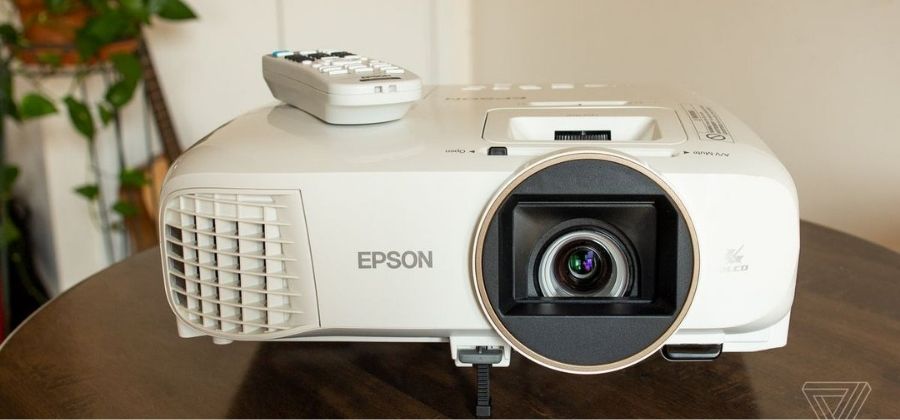We all know what a projector is, but how do projectors work? A projector is a machine that displays a film or image onto a screen. The device has a slot called a feed reel where you put the film through. The projector then unrolls the film so it can shine light through it and project the images onto the screen.
The first projector was invented by Scottish inventor, mathematician, astronomer and alchemist – James Watt (1736-1819). He created his version of the “magic lantern” using an oil lamp with lenses inside. This enabled large slides to be projected onto screens. His idea was taken up by other people who later perfected this kind of technology into what we have today. Currently, the only makers of projectors are architecture and design firms.
What are the different types of projectors?

When thinking about how do projectors work, you should consider these types: Liquid-crystal display (LCD), Digital Light Processing (DLP) and Laser.
Liquid-Crystalline Display (LCD) Projector:
A Liquid-crystalline display (LCD) projector works by shining light through liquid crystals. The crystals are sandwiched between two transparent glass plates with electrodes attached to the edges of each one. When an electric current is passed through the crystal, it turns dark on one side and bright on the other. Each tiny crystal can work as a shutter so different images can be projected onto the screen at the same time.
The LCD projector has replaced traditional film projectors because they are cheaper to run and easier to transport around than heavy reels of film. They also produce better pictures than DLP projectors because there is no need for any kind of filter to mix colours together – this makes them brighter and clearer than most other types!
A Digital Light Processing Projector (DLP):
A Digital Light Processing Projector (DLP) works slightly differently to an LCD projector. It separates white light into red, green, and blue components and uses a DMD special chip to project these onto the screen. The image is created by tiny mirrors on the chip that reflect the coloured light onto the screen where it mixes together to create an image or video. This type of projector has been around for many years but isn’t perfect. Because there are so many mirrors that need moving, you can still get a “rainbow effect” even though this system tries its best to stop it!
Laser projectors:
Laser projectors use lasers – not real lasers like those used in science fiction films! A laser projector works by shining a laser onto a holographic disc. A computer chip in the projector then creates red, green and blue light which mixes together to form the image. This system is very good at creating clear images without any kind of “rainbow effect” or flickering problems.
How to choose the right projector with the right features?
Now you know a bit more how do projectors work, you might think about buying one. Your first step is going to be thinking about all the features that are available on different types of projector – they include:
Brightness Technology Image quality Ports Connections Cost
These points might help as a guide when considering what type of projector you want and what it’s going to need from your device. If money isn’t an issue, then go for the most expensive one because this will give the best picture quality! But if your budget is really tight, then choose a cheaper model but don’t sacrifice too much on image quality or brightness as a good picture is a must-have feature.
Remember nobody wants to see a fuzzy image! So if you are in the market to buy a projector, think about what type of features you want it to have. Think about where you will use it most often (home cinema or gaming) and whether you need any input connections (USB, HDMI etc.). Then choose your projector according to its purpose.
How many lumens do I need?
The number of lumens is an important feature if you’re buying a projector for home cinema use – especially if there isn’t much space between the screen and the sofa! You need at least 1000 lumens to brighten the image when projected onto a light coloured wall or screen during daytime conditions. A few projectors can even produce images in very bright rooms with only 300-500 lumens, but in most cases, you will need a minimum of 500 lumens for when watching movies in daylight.
How much contrast ratio do I need?
If your projector is going to be used mainly in the evenings when it’s dark, then you can get away with a lower contrast ratio – somewhere around 800:1 (dynamic) is fine. However, if the images are to be viewed in bright light conditions, the higher your contrast ratio, the better! Some projectors can produce images with an incredible dynamic ratio of up to 100,000:1 which means they produce incredibly clear and crisp pictures even when there is bright sunlight or very little ambient light. With this kind of performance, image quality will not let you down no matter where you’re using your projector.
What technology do I need?
LCD projectors have the advantage of producing high-quality images at lower costs than other types of projectors. Some models even have amazing statistics such as 5000:1 contrast ratios or 4000 lumens, so although they might not be as expensive as DLP projectors, they still provide a great picture! LED projectors can also produce very clear images with incredible color depth and brightness levels even though most models don’t have the contrast ratios than LCD models do.
You also have less chance of seeing any “rainbow effect” which means that this is a good type of projector to choose if you’re on a tight budget or aren’t sure how serious you are about projecting videos and movies onto a screen for home entertainment. If you’re looking for a projector with low operating costs and doesn’t cost the earth to buy, LED projectors are worth considering as they use less electricity than other types.
DLP projectors have been used in offices and schools for decades because of their ability to produce incredibly bright images even when there is very little ambient light – this means that these projectors can be used during daylight hours without any significant problems. The only drawback with DLP technology is that some models suffer from “rainbow effect” or flickering images which can be an incredible annoyance if you move your eyes around the screen too quickly!
How to buy the best projector for your home?

When you are looking to buy a projector, don’t just think about what kind of features it has and how expensive it is. It’s also important to establish where you’re going to use your projector most often because although projectors can have all types of amazing features, they aren’t worth very much if the picture quality isn’t good enough. Ask yourself some questions before choosing a model:
Where am I going to watch videos? In which room is the projector going to be used most often? What type of lamp does my chosen model have? How can I connect my laptop or games console to my new projector?
If you want the best from your home cinema experience in terms of both performance and price, then a DLP model with a high contrast ratio is probably your best option. If you want a projector for use during the day and in bright light conditions, then an LCD model with 5000:1 contrast ratio is also worth considering. LED projectors are good if you want to save money on operating costs but be aware that most models don’t have very high contrast ratios or brightness levels – this means that they’re only really suitable for watching movies and videos during the evening/night time when it’s dark!
Conclusion:
Projectors are a fantastic way to add a visual element to any presentation, event, or meeting. Most people, however, don’t know how do projectors work. We hope that you found this article enlightening and that it added some valuable knowledge to your day! If you’re interested in learning more about projectors, we encourage you to check out our blog . We’re always posting valuable information for you to use in your business. You can also connect with us on Facebook and Twitter.






